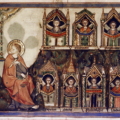In Sicily, more than three hundred churches are dedicated to Saint James the Apostle. It is clearly a testimony to the intensity of popular devotion. A stretch of the famed Way of St. James also crosses the island –from Caltagirone to Capizzi.
Sicily was once part of the crown of Aragon. Thinking it was the Spaniards who introduced the devotion to their beloved patron saint makes sense. However, when the Aragonese arrived on the island, they already found a deeply rooted Jacobean tradition: Agrigento, Partinico, Acquedolci, Messina, Licata, Comiso, Capizzi and Castronovo di Sicilia already had churches, chapels, and shrines dedicated to the saint for centuries.
Digging into these Sicilian Jacobean traditions (some as peculiar as the stoning of the rooster) leads to unexpected discoveries. One of them belongs in the gaming industry.
The surprising Roger
Age of Empires needs no introduction. Since 1997, this series of strategy-based video games has found in the epic deeds of the past the narratives it needs. Consequently, this immensely popular game has helped to dust off some of the great figures that have already been long forgotten in history classrooms.
Fans of Age of Empires II: Lords of the West will recognize the name Roger de Hauteville. The campaign designed for the game recreates the 11th-century conquest of Sicily by this Norman knight and adventurer, under his older brother and feudal lord. But he is a character worth knowing more about.
The Hautevilles descended from the Vikings. A passion for adventure was thus part of their family heritage. Settling in Normandy and embracing Christianity by no means extinguished that fire, and soon many of them were roaming Europe as adventurers, mercenaries, pilgrims, and even bandits. Roger arrived in Italy through the Via Francigena to join his older brothers who had already conquered noble titles (and territories, via conquest) in the south of the country.
It is known that Roger was handsome and rather tall, but also intelligent and well-educated, with a cheerful and friendly character. This is how he was described by Godfrey of Malaterra, a Benedictine monk who accompanied him in his heroic deeds and wrote them down for posterity in De rebus gestis Rogerii et Roberti Guiscardi.
Liberation of Sicily
The political map of southern Italy in Roger’s time could not have been more complex. On one side were the Lombards and on the other the Byzantine Greeks, squabbling among themselves and harassed by the Saracens, who constantly raided their coasts. In Sicily, there was a Muslim emirate made up of feuding taifas. To complicate matters, traditional tensions with the Pope of Rome were quite common.
Chronicles explain that the first Normans arrived as pilgrims returning from Jerusalem or going to San Michele in the Gargano. But their reputation as warriors offered them many opportunities to prosper in the service of different factions –so many decided to stay.
The Hauteville brothers chose to join the Lombards and help them drive out the Greeks. But soon enough they became independent, and Pope Nicholas II, wishing to attract them to his side, appointed Robert Duke of Apulia, Calabria and Sicily, “in advance”.
The Pope’s “prophetic” appointment spurred Roger on to conquer the then Muslim island for his brother –and for the Christian faith. With only a few hundred soldiers, he launched an attack in a “David vs. Goliath” style campaign that eventually lasted 30 years. There were famous moments such as the battle of Cerami, where Malaterra claims that Roger defeated an army of 15,000 Muslims with just a hundred men. These figures are probably exaggerated, but historians agree that the Normans were far outnumbered.
A Vision of Saint James
In July 1090, with the conquest almost complete, the Muslims made an agonizing challenge to Roger at Caltagirone. The night before the decisive victory, legend claims that the knight had a vision of St. James the Apostle with a sword in his hand –the very same vision of James The Moor Slayer that tradition says Ramiro I and the Christian troops are had at the Battle of Clavijo in Spain, in 844. The Vow of St. James was instituted, by which the Christians committed themselves to make a pilgrimage to Compostela to give thanks for their victory.
The same happened in Sicily, where churches dedicated to the apostle soon multiplied. The island became part of the road to Compostela, a place of safe passage for pilgrims traveling by sea. But it also became a place of pilgrimage in itself, especially to the sanctuaries of Capizzi and Messina.
In the last years of his life, Roger became a great friend of another giant of the Middle Ages, St. Bruno –the founder of the Carthusians. He gave him land to start a monastery in Calabria, the now famous Certosa di San Bruno. The saint accompanied him on his deathbed, helping him say farewell to a truly extraordinary life.





